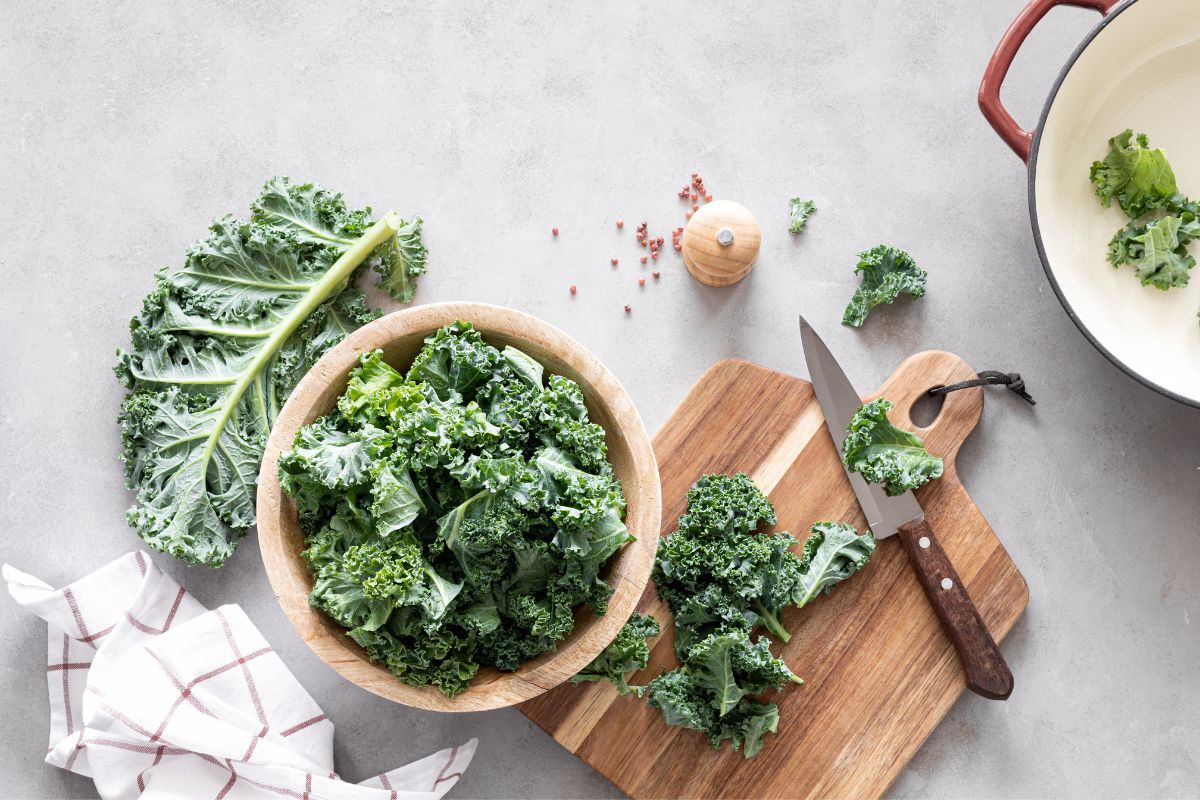Kale is notorious for its fantastic nutritional value and great health benefits! It is a common ingredient in many different superfoods including smoothies and juices.

We have compiled lots of information about this delicious leafy green including its taste, color, and texture. Read on for all of the information about kale that will cover your unanswered questions! Let’s dive in!
What Is Kale?
Kale is a delicious and hearty leafy green. It comes from the Brassica family which is known for being rich in nutrients. Kale is closely related to cabbage, so kale leaves can be very tough.
Kale is much heartier than a lot of other leafy greens as it contains lots of nutrients, iron, and calcium! It is also rich in antioxidants, fiber, and glucosinolates.
Kale has a very thick stem and thick veins on the leaves. 30 percent of the weight of kale is in the stem and ribs. As the stem doesn’t soften, this can put a lot of people off! For this reason, a large number of chefs will remove the stem before cooking.
There are two varieties of kale.
Brassica Napus
The Brassica Napus is a curly-leafed variety of kale. For example, Siberian kale and Red Russian kale fit into this category.
Brassica Oleracea
This refers to smoother-leaf varieties such as Dinosaur kale or Lacinato.
What Does Kale Taste Like?
Kale has a very specific taste that is not like many other leafy greens. It has a very earthy taste.
Kale leaves are tough and crunchy and they have a very strong taste. Young kale has much softer, thinner leaves that have a much milder taste.
Young kale can work on its own in a salad, but you will want to cut mature kale into small ribbons and blend it with lettuce in a salad.
Red Russian kale tastes a lot sweeter than the other varieties of kale. If your Red Russian kale has been growing through a frost, then it will taste much sweeter than kale that has grown in an area where there has been no frost.
Kale will taste best if you cook it immediately after picking it. Older kale can taste more bitter and it will have much tougher leaves.
What Does Kale Look Like?
The color of kale can differ depending on the variety. It can be medium green, purple, or dark green.
The leaves can also vary depending on the variety of kale. They can be curly or straight and have ruffled or puckered leaves.
When Is Kale Grown?

Kale is grown all year round in grocery stores. Kale season is from October to March, during the colder months. It is hardy enough to last through the cold winters, and it can grow through frost and snow.
Kale is a great crop to grow during the winter when a large number of other plants would not survive in the cold.
Cooked Kale
Cooking your kale means that the flavor becomes a lot milder. For this reason, a lot of people prefer to cook the leafy green rather than eat it raw.
When cooked, the leaves will become a lot softer and the taste will be less powerful than other cooked foods.
You can cook kale in several different ways including:
- Steaming
- Boiling
- Roasting
- Sautéing
Health Benefits Of Kale
Kale has a large number of different health benefits so it is very useful to add it to your diet. These health benefits include:
Highly Nutritious
It has several different nutrients, including vitamin K, vitamin C, and manganese. It is low in calories, making it a great way to boost your intake of key vitamins and minerals. It also contains vitamin B6, potassium, magnesium, and iron.
Antioxidants
Kale is very high in antioxidants. It has a lot of vitamin C and beta-carotene in it. These antioxidants protect you against aging and other chronic conditions. It has been proven to protect you against cancer.
These antioxidants help to ease inflammation, protect against chronic illnesses, and support heart health.
Source Of Vitamin C
Kale is a great source of vitamin C and it is vital to many of the body’s functions, including producing collagen. Vitamin C improves your immune system and helps your body fight off disease and infection.
Calcium
Kale is very high in calcium which is very important for the health of your teeth and bones. It is also high in magnesium which protects your body against diabetes.
How To Choose Healthy Kale
Healthy kale will have very strong and crisp leaves. Kale leaves should look vibrant and fresh.
It is important to use kale when it is still fresh. Try to use it up within a week so that it is nice and fresh.
You should store your kale in the refrigerator. Before placing the kale in the fridge, use a paper towel to absorb any excess moisture. Then, place the kale in a sealed plastic bag in the refrigerator.
How Do You Clean Kale For Cooking?
Cleaning kale is very important and you should make sure that you clean it thoroughly.
To clean it effectively, first you should place the chopped kale in an ice container and wait for the dirt to fall to the bottom.
Once this has happened, transfer the kale into another container using a spoon with slots for the water to drip through. If the kale is still dirty, repeat this process until the water is clean.
Common Varieties Of Kale

Curly Kale
The leaves on curly kale are usually blue-green and very curly. Curly kale is usually cooked because it can be very tough.
Red Russian Kale
The leaves on red Russian kale are green-gray. They often have purple-colored veins. It is a great kale to grow in the garden and the younger leaves will taste a lot better. Red Russian Kale that is too old will have a very bitter taste.
Tuscan Kale
The leaves of Tuscan kale can grow up to two feet long. This variety will produce a large crop, producing more kale every week. This is a very hardy variety that can produce kale throughout the winter and in the heat.
This kale has a much milder flavor, making it ideal for raw salads.
Ways To Cook Kale
There are lots of different ways that you can add kale to your diet.
Make It Crispy
You can make your kale chips very easily. All you will need to do is add some salt and other seasonings to your kale, and place them in the oven. Lay them out on a tray and wait until the heat crisps the kale up.
Braise It
Another way that you can enjoy kale is by braising it. This is when you cook the kale slowly in liquid. This method of cooking kale makes it more tender and allows it to take on the flavor of whatever you are cooking it with.
Sauté It
You can also sauté kale. Add some butter to the pan and heat the kale on medium heat. You can also add any spices that you want to give it some extra flavor.
Roast It
Roasting kale is a very simple way to cook it. This method of cooking kale will allow it to wilt nicely. You can add oil and spices as you prefer.
Use It In Salads
Kale is a great base for salads. It won’t wilt in the same way as other leafy greens do.
Steam It
You can also steam your kale. To do this, you should lay it out in a colander or steamer over a pot of boiling water. Let the kale cook for around 5 to 10 minutes until it is tender. This method of cooking kale will leave you with deliciously soft kale that you can serve with several dishes.
Add It To Smoothies
Adding kale to your smoothie is another way to consume all of the nutrients that it has to offer. If you opt for adding it to a smoothie, you won’t notice all of the intense flavors too much.
Kale goes very well with avocado, blueberries, or mango. You can experiment with lots of different kinds of fruit and vegetables!
Final Thoughts
So, there you have it! You should now have all the information you need to answer all of your questions surrounding kale. You’ll now know what it tastes like and why you should implement it into your diet!
- How To Reheat A Cheesesteak - November 5, 2023
- What Are Three Must Have Kitchen Knives? - September 22, 2023
- How To Protect Edges Of Pie Crust - June 15, 2023








